Quiz Answer Key and Fun Facts
1. Windmills were once an essential part of the local British economy. What is the correct term for the long arms on the front that turn in the wind?
2. Without these devices the pottery industry could not have existed. What are they?
3. Stannery buildings such as this are seen all over the Cornish landscape. What was a stannery?
4. Water wheels were the original powerhouse of the Industrial Revolution. What is the stream of water that powers the wheel called?
5. Once cotton mills dominated much of Manchester and neighbouring English towns. What was the term used to describe this area?
6. In the pre-digital age, printing was done on large, heavy presses. Who or what was a printer's devil?
7. 'Mad as a hatter' is a phrase that comes to us from the hat-making industry. What material used in hat-making caused dementia in many workers?
8. The traditional barber's pole, many of which can still be seen, has red and white stripes. Why was this?
9. Pollution from factory chimneys caused an area of the West Midlands in England to be called what?
10. Cordwainers traditionally made what items?
Source: Author
Christinap
This quiz was reviewed by FunTrivia editor
Pagiedamon before going online.
Any errors found in FunTrivia content are routinely corrected through our feedback system.


